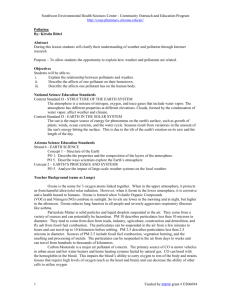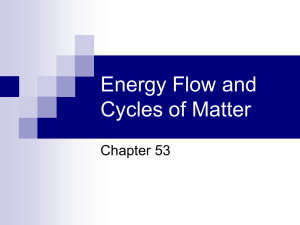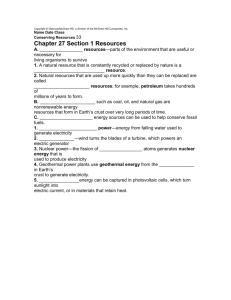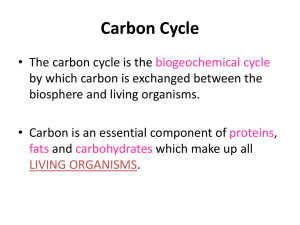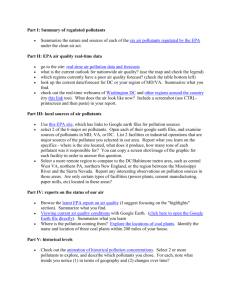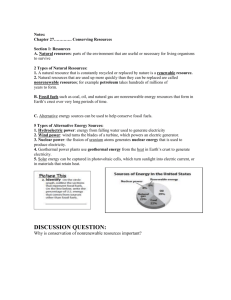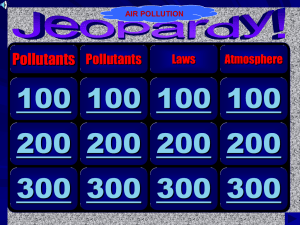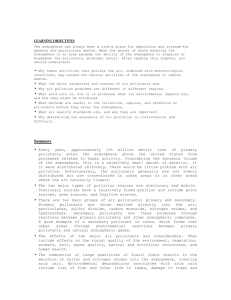Ng.1998GasFlareStudyChapter3
advertisement
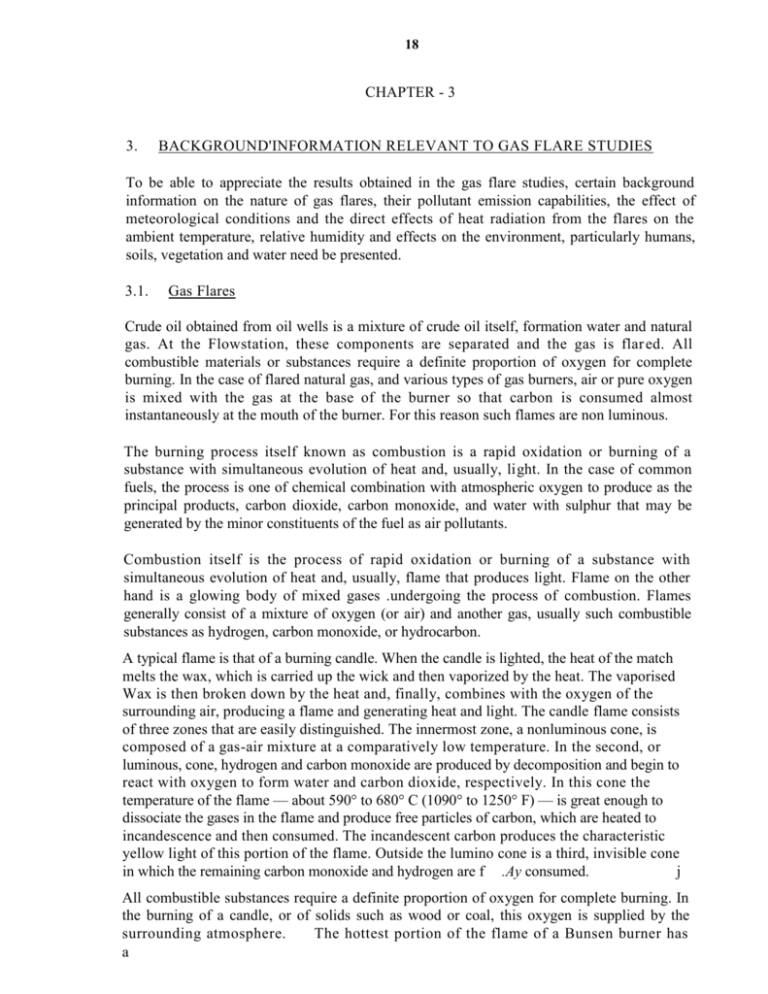
18 CHAPTER - 3 3. BACKGROUND'INFORMATION RELEVANT TO GAS FLARE STUDIES To be able to appreciate the results obtained in the gas flare studies, certain background information on the nature of gas flares, their pollutant emission capabilities, the effect of meteorological conditions and the direct effects of heat radiation from the flares on the ambient temperature, relative humidity and effects on the environment, particularly humans, soils, vegetation and water need be presented. 3.1. Gas Flares Crude oil obtained from oil wells is a mixture of crude oil itself, formation water and natural gas. At the Flowstation, these components are separated and the gas is flar ed. All combustible materials or substances require a definite proportion of oxygen for complete burning. In the case of flared natural gas, and various types of gas burners, air or pure oxygen is mixed with the gas at the base of the burner so that carbon is consumed almost instantaneously at the mouth of the burner. For this reason such flames are non luminous. The burning process itself known as combustion is a rapid oxidation or burning of a substance with simultaneous evolution of heat and, usually, light. In the case of common fuels, the process is one of chemical combination with atmospheric oxygen to produce as the principal products, carbon dioxide, carbon monoxide, and water with sulphur that may be generated by the minor constituents of the fuel as air pollutants. Combustion itself is the process of rapid oxidation or burning of a substance with simultaneous evolution of heat and, usually, flame that produces light. Flame on the other hand is a glowing body of mixed gases .undergoing the process of combustion. Flames generally consist of a mixture of oxygen (or air) and another gas, usually such combustible substances as hydrogen, carbon monoxide, or hydrocarbon. A typical flame is that of a burning candle. When the candle is lighted, the heat of the match melts the wax, which is carried up the wick and then vaporized by the heat. The vaporised Wax is then broken down by the heat and, finally, combines with the oxygen of the surrounding air, producing a flame and generating heat and light. The candle flame consists of three zones that are easily distinguished. The innermost zone, a nonluminous cone, is composed of a gas-air mixture at a comparatively low temperature. In the second, or luminous, cone, hydrogen and carbon monoxide are produced by decomposition and begin to react with oxygen to form water and carbon dioxide, respectively. In this cone the temperature of the flame — about 590° to 680° C (1090° to 1250° F) — is great enough to dissociate the gases in the flame and produce free particles of carbon, which are heated to incandescence and then consumed. The incandescent carbon produces the characteristic yellow light of this portion of the flame. Outside the lumino cone is a third, invisible cone in which the remaining carbon monoxide and hydrogen are f .Ay consumed. j All combustible substances require a definite proportion of oxygen for complete burning. In the burning of a candle, or of solids such as wood or coal, this oxygen is supplied by the surrounding atmosphere. The hottest portion of the flame of a Bunsen burner has a 19 temperature of about 1600° C (about 2910° F). The hottest portion of the oxygen-acetylene flames used for welding metals reaches 3500° C (6330° F); such flames have a bluish-green cone in place of the luminous cone. If the oxygen supply is reduced, such flames have four cones: nonluminous, bluish-green, luminous, and invisible. The blue-green cone of any flame is often called the reducing cone, because it is insufficiently supplied with oxygen and will take up oxygen from substances placed within it. Similarly, the outermost cone, which has an excess of oxygen, is called the oxidizing cone. Most combustion processes release energy, or heat, for the production of power, for use in industrial processes, and for domestic heating and lighting. Combustion is also a means of producing a desired oxidised product, as in the burning of sulfur to produce sulfur dioxide and ultimately sulphuric acid. In addition, it is a method for disposing of wastes. The energy released by combustion causes a rise of temperature of the products of combustion. The temperature attained depends on the rate of release and dissipation of the energy and the quantity of combustion products. Air is the cheapest source of oxygen, but because air is three-quarters nitrogen by weight, nitrogen becomes the major constituent of the products of combustion, and the rise in temperature is substantially less than if pure oxygen were used. Theoretically, in any combustion, a minimum ratio of air to fuel is required for complete combustion. The combustion, however, can be made more readily complete, and the energy released maximised, by increasing the amount of air. An excess of air, however, reduces the ultimate temperature of the products and the amount of the released energy. Therefore, an optimum air-to-fuel ratio can almost always be determined, depending on the rate and extent of combustion and the final temperature desired. Air with enriched oxygen content or pure oxygen, as in the case of the oxyacetylene torch, may be used to produce high temperatures. The rate of combustion may be increased by finely dividing the fuel to increase its surface area aid hence its rate of reaction, and by mixing it with air to provide the necessary amount of oxygen to the fuel. 3. 1.1. Liquid and Gaseous Fuels Gaseous fuels such as natural gas, refinery gas, and manufactured gases such as producer gas 'are usually mixed with air before combustion to supply a maximum amount of oxygen to the fuel. The fuel-air mixture then issues from the burner ports at a velocity greater than the velocity of flame propagation to prevent flame flashback into the burner, but not so great a velocity as to blow the flame off the burner. If not premixed with air, these fuels usually burn with smoky, relatively cool flames. Natural gas burned with air can produce flame temperatures in excess of 1930° C (3500° F). Because of the critical role of combustion in the production of power, a great deal of research effort is devoted to finding ways to burn fuels more efficiently. Researchers also seek to reduce the pollutants released by combustion, since these products contribute greatly to environmental problems such as air pollution and acid rain (Treybal, 1997). 3. 1.2. Pollutants From Gas Flaring Air Pollution is the contamination of the atmosphere by gasc », liquid, or solid wastes or byproducts that can endanger human health and the health and welfare of plants and animals, or can attack materials, reduce visibility, or produce undesirable odors. I f; 20 Each year, industrially developed countries generate billions of tons of pollutants. The level is usually given in terms of atmospheric concentrations (micrograms of pollutants per cubic meter of air) or, for gases, in terms of parts per million, that is, number of pollutant molecules per million air molecules. The principal pollutant from fuel burning as in gas flaring are carbon dioxide, carbon monoxide, oxides of nitrogen and sulphur dioxide. Oxides of carbon and sulphur may be generated by the minor constituents of the fuel. Nitrogen oxides are products of th e combustion process. Molecular nitrogen begins to oxidise at about 1204 °C (2204 °F) (Fenelly, 1984). Thus oxides of nitrogen i.e. thermal NOX would easily be produced by flares if their temperatures are above 1204 °C (2204 °F). Natural gas burned with air can produce flame temperatures in excess of 1930 °C (3500° F) (Treybal, 1997). Townead (1969) using the D-Line reversal, method for the measurement of flame temperatures obtained a temperature of 1870 "C and 3000 °C respectively for 10 % CH 4 and 33% in oxygen. Considering the fact that flared gas is over 80% CH 4, flare temperatures between 1870 °C and 3000 !'C would be expected as obtained by Treybal (1997) and temperatures in this range art i'ar above the 1204 °C at which molecular nitrogen begins to oxidise. In Table 3.1 are presented the important atmospheric pollutants. 21 Table 3.1: Important Atmospheric Pollutants Type Carbon monoxide Carbon dioxide Flourine .Nitrogen dioxide Sulphur dioxide Dust Hydrogen sulphide Source Effects Monitoring Incomplete combustion of carbonaceous materials. Main source is from petrol engines. Naturally occurring, but also produced by the combustion of carbonaceous fuels. Brick and aluminium products. A flammable gas, toxic to humans. Detection tubes or gas monitor. Contributes to the 'greenhouse effect'. Detection tubes or landfill'gas monitor. Detector tube. Produced naturally by volcanoes. Also from burning fossil fuels and from vehicle exhaust. Produced naturally by volcanoes. Also from heavy industry and burning fossil fuels. Industry, vehicles, mining and construction work. Produced naturally by saline marshes and geothermal springs. Also from coke production, waste water treatment and wood pulp production. Corrosion, acid gas, Toxic to man in high concentrations. Causes flourosis in animals and damages vegetation. Toxic to humans and animals. Contributions to acid rain. Detector tubes or gas monitor. Toxic to humans and some plants. A major component of acid rain. Detector tubes or gas monitor. Some dusts are directly toxic to humans. Also damaging to many plants. Highly toxic to humans and animals. Air sampling pump or digital aerosol monitor. Detector tubes or gas monitor. The nature of the pollutant gases are as follows: 3.1.3. Nitrogen Oxides (NO,) The three oxides of nitrogen normally encountered in the atmosphere are nitrous oxide (N2O) nitric oxide (NO), and nitrogen dioxide. Nitrous oxide is microbiologically generated and is relatively unreactive. Colourless, odourless nitric oxide (NO) and pungent red -brown nitrogen dioxide (NO2) are collectively designated as NOX. These gases enter the atmosphere from natural sources, such as lightening and biological processes. Practically all antropogenic NO2 enters the atmosphere as a result of combustion of fossil fuels in both stationary (such as gas flares) and mobile sources generated from the internal combustion engines of automobiles. Most NO2 entering the atmosphere from pollution sources does so as NO generated from internal combustion engines. At the very high temperatures, in an automobile combustion chair1 , me following reactions occurs: N, O2 -> 2 NO High temperatures favour both a nigh equilibrium concentration and a rapid rate of formation of NO. Rapid cooling of the exhaust gas from combustion, "freezes" NO at a relatively high concentration because equilibrium is not maintained. Thus by its very nature, the combustion process both in the internal combustion engine and in furnaces produces high levels of NO in the combustion products (Manahan, 1993). Although NO is the primary form in which NO X is released to the atmosphere, the conversion of NO to NO2 is relatively rapid in the atmosphere. 3. 1.4. Carbon Monoxide (CO) Carbon monoxide (CO) causes problems in cases of locally high concentrations. The overall atmospheric concentration of carbon monoxide is about 0.1 ppm. Much of this CO is present as an intermediate in the oxidation of methane by hydroxy radical. Carbon monoxide ..emission from internal combustion engines in congested urban areas traffic may reach levels as high as 50 - 100 ppm. In cities, CO concentrations is usually between 1 and 55 ppm with an average of 10 ppm. But detectable clinical symptoms appear at 100 ppm and humans are killed at 1,000 ppm (Simmons, 1981). 3.1.5. Sulphur Dioxide (SO 2 ) Sulphur dioxide (SO2) enters the global atmosphere through anthropogenic activities, primarily as SO2 from the combustion of coal and residual fuel oil. Although produced in smaller quantities than CO, SO2 is much more toxic. I 3. 1.6. Meteorology and Health Effects of Pollutants Pollutant concentrates are reduced by atmospheric mixing, which depends on such weather conditions as temperature, wind speed, and the movement of high and low pressure systems and their interaction with the local topography, for example, mountains and val leys. Normally, temperature decreases with altitude. But when a colder layer of air settles under a warm layer, producing a temperature or thermal inversion, atmospheric mixing is retarded and pollutants may accumulate near the, ground. Inversions can become sustained under a stationary high-pressure system coupled with low wind speeds. Often, the first noticeable effects of pollution are aesthetic and may not necessarily be dangerous. These include visibility reduction due to tiny particles suspended in air, or bad odours, such as the rotten egg smell produced by hydrogen sulfide emanating from pulp and paper mills. 3.1.7. TJ- -Scale Effects The Lail flare and smokestacks used by industries and utilities do not remove pollutants but simply boost them higher into the .atmosphere, thereby reducing their concentration at the site. These pollutants may then be. transported over large distances and produce adverse effects in areas far from the site of the original emission, Sulfur dioxide and nitrogen oxide emissions from the central and eastern U.S. are causing acid rain in New York State, New England, and eastern Canada. The pH level, or relative acidity, of many freshwater lakes in that region have been altered so dramatically by this rain that entire fish populations have been destroyed. Similar effects have been observed in Europe. Sulfur dioxide emissions and the subsequent formation of sulfuric acid can also be responsible for the attack on limestone and marble at large distances from the source (Wadden, 1997). 3.2 AIR POLLUTION, ATMOSPHERIC DISPERSION OF POLLUTANTS, AND THE QUALITY OF LIFE In environmental surveys, it is sometimes necessary to characterise several parameters and the diffusion of the gases. Wind constitutes the determining factor along with some atmospheric phenomena such as rainfall and temperature. Other physical parameters that affect the diffusion of pollutants in the atmosphere are pressure, humidity and sunlight. All these parameters are usually studied by meteorological science to interprete dynamic phenomena of the lower atmospheric strata, which have major relevances on the ^environmental studies of an area. The low atmospheric strata (troposphere up to 18,000 meters) present a negative temperature gradient which has a value of about 1 degree centigrade per 100 meters. That is, the temperature decreases by one degree each 100 meters of elevation (dry adiabatic gradient). The term dry refers to air with a vapour content which is less than that of saturation. The effects of the eonveetive mixing of the air due to the presence of a negative temperature gradient are not the only cause of the mixing of the atmospheric air. The wind radically adds to the phenomenon and can improve or worsen the dispersion of gaseous pollutants. 24 3.3. ATMOSPHERFC MODELS Numerous air dispersion models with general or limited geographic applicability have been developed with the objective of deducing ground level concentrations, and hence exposures, from stack emissions. Most texts or handbooks on air pollution contain full descriptions of such models. The general approach is to define first the emission rate or strength of one or more sources in units such as kg/day. Since most discharges to the atmosphere are from stacks, it is usually necessary to deduce a plume rise height, yielding an estimate of the height at which contaminant is released. The chemical then blows downwind and disperses horizontally and vertically, diluting steadily. A "map" of concentrations as a function of position can then be assembled, provided that information is available on the dispersion characteristics. These take the form of standard deviation terms in the Gaussian distribution equation and are functions of v ind speed and atmospheric stability. Of most interest are ground level concentrations which control human exposure. Models range from simple application of Gaussian dispersion equation to complex, multisource models containing allowance for depositing particles and topographic features of the terrain. It is~possible to calculate the pollutant concentration emitted to different distances from the point of emission using diffusion models. The parameters utilised to calculate the concentrations are: velocity, winds, gradient, temperature, smoke temperature, emission point height, type of pollutant, and velocity emitted smoke. The diffusion model most used in literature is the Gaussian-type statistic which, associated with the six classes of atmospheric stability of Pasquill and related dispersion parameters, gives the concentration at the ground or in the air of a pollutant emitted by stationary sources (Fig.7). 3. 3.1 Mathematical Formulation Dispersion of a pollutant in the atmosphere is governed by the basic atmospheric diffusion equation. Under non-isotropic conditions, the atmospheric diffusion equation satisfying the v ran hp written nc- equation of continuity can be written as: where C is the pollutant concentration, S represents the source term, R is the removal terms, and u, v and w are the wind components and K x, Ky, and Kz are the eddy diffusivity coefficients along the x, y and z directions, respectively. Figure 7: Gas dispersion in the atmosphere from a point form emission source according to the hypothesis that the concentration varies around the smoke wreath axis with the Gaussian law. Dispersion of pollutants in the atmosphere is governed by the following dominant mechanisms (Wark and Warner, 1981): (1) (2) mean air flow that transports the pollutants downwind, and turbulent velocity fluctuations that disperse the pollutants in all directions. Wind speeds less than 2 m s"1 are generally considered to be low, as most of the conventional models for dispersion are to some extent suspect because of their assumptions when the wind speed falls below about 2 m s*1. These are of frequent occurrence at many sites, particularly in tropical regions and have a great potential for pollution episodes. Pasquill (1961) asserted that diffusion under low wind conditions is very irregular and indefinite. Later, several diffusion experiments under light-wind, stable conditions supported Pasquill's assertion and indicated that effective estimates of dispersion co-efficients (cr's) can correspond to any atmospheric stability. Under low wind conditions during daytime, instantaneous plume usually does not spread much horizontally whereas during night it can meander over a wide angle (Etling, 1990). The resulting observed concentration distribution is non-Gaussian and multi-peaked. As is evident from field experiments and theoretical considerations (Kristensen et at., 1981; Hanna, 1983), averaged concentration of pollutants under meander conditions can be a factor 2-6 lower than for the situation with straight plumes downwind of the point sources. In most of 26 the Gaussian plume models, when mean wind speed becomes very low ( < 2 m s"1 ) the pollutant concentration tends to go exceptionally high because U appears in the denominator. Thus, it has become necessary to study dispersion patterns during low wind conditions. Generally, under moderate to strong winds, diffusion in the direction'of wind is neglected in comparison to advection. But this may not be the case in low winds and, consequently, diffusion'could be comparable with advection in the direction of wind. Arya (1995) has shown that the conditions under which downwind diffusion might be important are essentially strong convection and weak winds (U< 1.5 m s"1). 3. 4. AIR POLLUTION AND THE QUALITY OF LIFE The impact of air pollution on human health is our primary reason for being concerned about it. Thus we need to know (1) whether a direct relationship exists between levels of air pollution and the incidence of respiratory and other diseases and (2) if air pollutants harm animals and plants we depend on for food and fiber. Air pollutants released from various sources affect directly or indirectly man and his environment. The resulting ground level concentration patterns have to be estimated for a wide variety of air quality analyses for social planning and industrial growth. Air pollutants emitted from different sources are transported, dispersed or deposited by meteorological and topographical conditions. 3. 4. 1. Effects On Human Health (■?■•■ Many parts of the human body are targets of a wide variety of air pollutants, but the initial attack of pollutants occurs primarily through the respiratory system. Air that we inhale follows a long pathway through oral and nasal passages, the windpipe, and the bronchioles before it finally reaches the air sacs (alveolar sacs) of the lungs. Within the air sacs, the 'oxygen is removed from the air by red blood cells, which then carry it to all parts of the body. If a person's blood is deprived of its oxygen supply, the person will succumb to asphyxiation, or oxygen starvation. Since pollutants are inhaled into the respiratory tract along with air, they can follow the same route to the air sacs. In sufficiently high concentrations, some air pollutants, such as carbon monoxide, are asphyxiating agents. Other pollutants, for example, certain particulates, irritate the tissues of the respiratory tract itself. Defense Mechanisms of the Body: We are not entirely at the mercy of air pollutants, because the respiratory system is armed with defense mechanisms. For example, nasal hairs filter out large particles. Also, the linings of the nose, windpipe, and bronchioles are covered with sticky mucus that captures small particles, including most dust and pollen, and absorbs some gaseous pollutants. The mucus and the pollutants it captures are transported upward to the mouth by the continuous beating of millions of cilia which are tiny hairlike structures that line most of the respiratory tract. Once the pollutant-bearing mucus reaches the mouth, it is either swallowed or expelled. Although the air sacs are neither lined with cilia nor produce mucus, they are equipped with formidable-looking cells, which are called macrophages. Those specialised, free-living cells engulf and digest foreign particle:;. In fact, each macrophage can comsume up to 100 bacteria 27 or pollen grains before it succumbs to the very poisons that it produces to kill the invaders. Many of those particle-laden macrophages reach the lower bronchioles, where they are caught up in the mucus and transported by the beating cilia to the mouth. Some inhaled materials act as irritants and elicit reflex responses in the lining of the respiratory systems. For example, coal dust triggers contractions of the mucus layers that surround the bronchi. Such a response narrows the interior of the passageway, which reduces further entry of inhaled coal dust. Many irritants also induce the reflex responses of sneezing and coughing. For example, sneezing expels irritants by a rapid expulsion of air in the upper part of the respiratory tract, whereas coughing forces air out of the bronchi. Gases: Our natural defenses cannot protect us from all attacks of air pollutants. For example, the quantity of gases that can dissolve in the mucus is quite limited. Unless a gas is degraded or removed by ciliary action, exposure for prolonged periods or to high concentrations may saturate the mucus, that is, exceed its capacity to dissolve any more. Then, if that oecurs, the gases can penetrate deeper into the respiratory tract. If the gas is one 'that acts as an asphyxiating agent and enough of it reaches the air sacs, it can displace the oxygen on the hemoglobin molecules (the transporters of oxygen in red blood cells). Hence as increasing concentrations of those gases are inhaled, the quantity of life-sustaining oxygen, which the bloodstream transports from the lungs, decreases. Asphyxiating agents also stress the heart. For example, persons who are afflicted with angina pectoris, which is a form of heart disease, appear to be parti cularly susceptible to asphyxiating agents. Lack of oxygen in the heart muscle causes angina victims (approximately 4.2 million in the United States) to suffer attacks of chest pain. In late 1977, the U.S. Council on Environmental Quality reported that the frequency of angina attacks increases as patients are exposed to higher levels of carbon monoxide. Hydrogen sulphide, which is an anaerobic decomposition product of organic material, is also an asphyxiating gas, but, unlike carbon monoxide, it does not displace oxygen in the blood. Rather, in very high concentrations (which can develop in confined places, such as sewers and mines), hydrogen sulphide impairs the part of the brain that controls the chest movements that are essential for normal breathing, causing almost instantaneous death. However, hydrogen sulfide is relatively harmless in the low concentrations we normally encounter, although we may find its rotten-egg odour unpleasant. I Gases that act mainly as irritants of the respiratory tract include ozone, sulphur dioxide, and nitrogen dioxide. Although each one causes a different reaction, the effects of those irritants generally include the discomforting symptoms of persistent coughing and heavy secretion of mucus. Particulates: Particulates that penetrate the natural defenses of the respiratory tract can cause illness and even death. The most severe problems result from lengthy exposure to relatively high concentration levels. For example, persons who experience lon g-term exposure to high levels of dust in occupations, such as mining, metal grinding, and the manufacturing of abrasives, can eventually develop lung diseases, which is usually named for the type of particulates involved. Such lung diseases include "black lung" (from coal dust), silicosis from quartz dust that is generated during mining, asbestosis (from asbestos fibers), I- 'browh lung", or byssinosis (from cotton dust). Depending on the type of particulate and the concentrations inhaled, the lungs may suffer irritation, allergic reactions, or scarring of tissue, which becomes a potential site for tumor development. Typically, victims ..experience coughing and shortness of breath and, in the long run, nay develop pneumonia, chronic bronchitis, emphysema, or lung cancer. Lead is a particularly widespread and troublesome particulate. It is emitted into the atmosphere primarily through the exhaust of vehicles that burn gasoline which contains lead as an antiknock additive. The danger of lead is exacerbated by the fact that it accumulates in the body more rapidly than it is excreted. We know little of the toxic threshold of lead in humans, but we are well aware that lead will poison children who eat lead-based paint chips. Lead poisoning attacks the blood-forming mechanism, the gastrointestinal tract, and, in severe cases, the central nervous system. It may also impair the functioning of the heart and the kidneys. Only 5 to 10 percent of lead that is ingested is retained by the human body, but 30 to 50 percent of lead that is inhaled is retained. At one time, scientists thought that the primary sources of our daily intake of lead were food and water—not the air that we breathe. But in the mid-1970s, the EPA compared the levels of lead in children who lived in Los Angels with those who lived in a rural area, which showed that the opposite is true. The higher levels of lead found in "the Los Angels group apparently resulted from the fact that those children breathed more lead. As discussed already, once a toxic substance is inhaled, the capacity of the mucus to remove those gases and particulates from the inhaled air can become limited as a result of saturation but, sometimes, other respiratory defenses are impaired by various inhaled agents as well. For example, some particles interfere with the cilia-mucus transport system, thereby increasing the amount of time that pollutants will remain in the respiratory tract. Such impairment may increase the likelihood of bronchial cancer if carcinogenic agents are retained in the lungs. Likewise, damage to macrophages may play a role in chronic lung diseases, such as emphysema and silicosis. It is sometimes argued that no certain link has been demonstrated between air pollution and respiratory diseases, such as emphysema and chronic bronchitis. But symptoms of bronchitis and. emphysema are similar to those attributed to inhalation of air pollutants, which suggests that those diseases may be at least aggravated by polluted air. In addition, the incidence of respiratory diseases is greatest in cities that have the highest levels of air pollution. Still, direct evidence that unequivocally links elevated atmospheric levels of a specific air pollutant to a particular respiratory disease is unusual. It is extremely difficult to prove the existence of such a connection, since the urban-industrial atmosphere contains numerous gases and particulates whose relative concentrations may be complex. Also, age, level of physical activity, and general health as well as the amount and frequency of exposure affects a person's reaction to polluted air. 3. 4.2. Impact on Other Species Experiments that involve laboratory animals contribute somewhat to our understanding of the effects of air pollutants on human health although, there are some serious limitations. Very 29 little is known about the impact of polluted air on the well-being of. other animals, most of which do not inhabit urban-industrial areas. In general, it appears that the two air pollutants that cause the most damage to other species are fluoride and lead. In both cases, organisms are affecled most commonly as a result of ingesting contaminated vegetation rather than by inhaling the pollutants. Dairy cattle are most sensitive to fluoride poisoning, which is called fluorosis. Fluorides reduce their milk production and attack their bones, producing lameness.r Chronic fluorosis eventually leads to severe emaciation and death. For example, substantial losses of cattle in Florida were attributed to fluoride emissions from factories that process phosphate deposits for fertilizers. In fact, in the middle and late 1950s, fluoride poisoning claimed the lives of 30,000 cattle in two fluoride counties. Fewer documented cases exist of lead poisoning in animals than of fluorosis, but the symptoms of this condition are no less debilitating. Afflicted animals lose their appetites, develop dry coats and muscle spasms, and frequently suffer paralysis of the hindquarters. Some zoo animals (especially members of the cat family) have been poisoned by their instinctive self-cleaning activities after their coats have been contaminated by airborne lead. Some of the most dramatic instances of air-pollution damage to vegetation have been caused by sulfur dioxide fumes from iron and copper smelters. Those emissions have virtually eliminated vegetation over large areas that are located adjacent to smelters. Ozone is another air pollutant that is hazardous to plant life, when it occurs in relatively high concentrations. The ill effects of ozone have been exhibited by grapes, sweet corn, lettuce, ,and pine. Most commonly, air pollution damages the leaves of plants. The waxy layer that covers leaves severely limits the amount of water that is lost through transpiration. However the surfaces of leaves are also equipped with tiny pores, which allow carbon dioxide to enter the plant for photosynthesis. But the open pores also allow a considerable amount of water vapour to escape from the leaves. When transpiration losses exceed the absorption of water by roots, as often happens on a hot, dry, windy day, those pores may close, which greatly reduces both the loss of water vapor and the entry of carbon dioxide and other gases into the leaf. 3.5. ENERGY TRANSFER IN THE ATMOSPHERE The physical and chemical characteristics of the atmosphere and the critical heat balance of the Earth are determined by energy. Incoming solar energy is large in the visible region of the spectrum. The shorter wavelength blue solar light is scattered relatively more strongly by molecules and particles in the upper atmosphere, which is why the sky is blue as it is viewed by scattered light. Similarly, light that has been transmitted through scattering atmospheres appears red, particularly around sunset and sunrise, and under circumstances in which the atmosphere contains a high level pi particles. The solar energy flux reaching the atmosphere is huge, amounting to 1.34 x 10 3 watts per square meter (19.2 kcal per minute per square meter) perpendicular to the line of solar flux at the top of the atmosphere. This value is the solar constant, and may be termed insolation, which stands for "incoming solar radiation." If all this energy reached the Earth's 30 surface and were retained, the planet would have vaporized long ago. As it is, the complex factors involved in maintaining the Earth's heat balance within very narrow limits are crucial to retaining conditions of climate that resulted in ice ages during some periods, or tropical conditions during others, were caused by variations of only a few in average temperature. Marked climate changes within recorded history have been caused by much smaller average temperature changes. The mechanisms by which the Earth's average'temperature is retained within its present narrow range arc complex and not completely understood, but the main features are explained'here. About half of the solar radiation entering the atmosphere reaches the Earth's surface either directly or after scattering by clouds, atmospheric gases, or particles. The remaining half of the radiation is either reflected directly back or absorbed in the atmosphere and its energy radiated back into space at a later time as infrared radiation. Most of the sol ar energy reaching the surface is absorbed and it must be returned to space in order to maintain heat balance. In addition, a very small amount of energy (less than 1% of that received from the sun) reaches the Earth's surface by convection and conduction processes from the Earth's hot mantle, and this, too, must be lost. Energy transport, which is crucial to eventual radiation of energy from the Earth is accomplished by three major mechanisms - conduction, convection, and radiation. Conduction of energy occurs through the interaction of adjacent atoms or molecules without the bulk movement of matter. Convection involves the movement of whole masses of air, which may be either relatively warm or cold. It is the mechanism by which abrupt temperature variations occur when large masses of air move across an area. As well as carrying sensible heat due to the kinetic energy of molecules, convection carries latent heat in the form of water vapor which releases heat as it condenses. An appreciab e fraction of the Earth's surface heat is transported to clouds in the atmosphere by conductior and convection before being lost ultimately by radiation.
